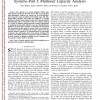Free Online Productivity Tools
i2Speak
i2Symbol
i2OCR
iTex2Img
iWeb2Print
iWeb2Shot
i2Type
iPdf2Split
iPdf2Merge
i2Bopomofo
i2Arabic
i2Style
i2Image
i2PDF
iLatex2Rtf
Sci2ools
96
Voted
TWC
2008
2008
On antijamming in general CDMA systems-part I: multiuser capacity analysis
Abstract--The capacity of a general multiuser CDMA jamming channel is analyzed when the receiver has or lacks jammer state information. Analyses are carried out for noncooperative and cooperative users in uplink and downlink static and Nakagami fading channels. The results are applied to a versatile multiaccess channel model which is based on the time-bandwidth dimensionality and is considered for the user capacity analysis of a variety of multiuser spread spectrum systems contaminated by jamming. In this model, different users are distinguished by signatures of either direct sequence or hopping type. It is found that the jammer should spread its energy evenly over all degrees of freedom in order to minimize the average capacity. Also, the capacity behavior appears to be dominated more by knowledge of jammer state information than by the effects of fading. The capacity of downlink channels in cooperative schemes is found to be more sensitive to changes in fading severity, compared with...
| Added | 16 Dec 2010 |
| Updated | 16 Dec 2010 |
| Type | Journal |
| Year | 2008 |
| Where | TWC |
| Authors | Reza Nikjah, Norman C. Beaulieu |
Comments (0)

